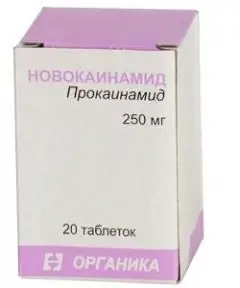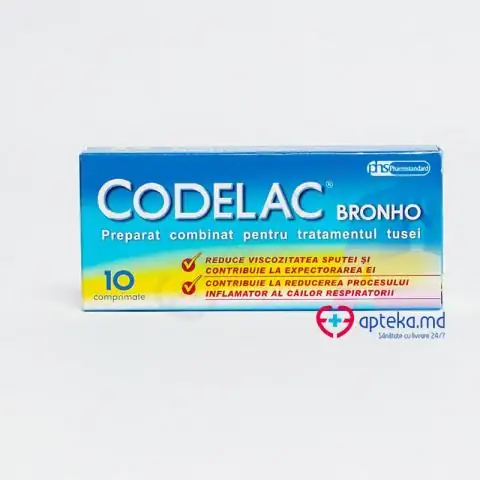- Author Rachel Wainwright [email protected].
- Public 2023-12-15 07:39.
- Last modified 2025-11-02 20:14.
Novocainamide
Novocainamide: instructions for use and reviews
- 1. Release form and composition
- 2. Pharmacological properties
- 3. Indications for use
- 4. Contraindications
- 5. Method of application and dosage
- 6. Side effects
- 7. Overdose
- 8. Special instructions
- 9. Application during pregnancy and lactation
- 10. Use in childhood
- 11. In case of impaired renal function
- 12. For violations of liver function
- 13. Use in the elderly
- 14. Drug interactions
- 15. Analogs
- 16. Terms and conditions of storage
- 17. Terms of dispensing from pharmacies
- 18. Reviews
- 19. Price in pharmacies
Latin name: Novocainamide
ATX code: C01BA02
Active ingredient: procainamide (procainamide)
Manufacturer: BINNOPHARM, CJSC (Russia), Moskhimpharmpreparaty them. N. A. Semashko, OJSC (Russia), Organika, OJSC (Russia), RUE "Belmedpreparaty" (Republic of Belarus)
Description and photo update: 2018-15-05
Prices in pharmacies: from 100 rubles.
Buy

Novocainamide is an antiarrhythmic drug.
Release form and composition
- Tablets (10 pcs. In blisters, in a cardboard pack 2 packs; 20 pcs. In dark glass cans, in a cardboard box 1 can);
- Solution for intravenous and intramuscular administration (5 ml each in ampoules made of neutral glass, in a pack of cardboard 10 ampoules complete with a scarifier or ampoule knife).
Each pack also contains instructions for the use of Novocainamide.
Active substance: procainamide, in 1 tablet - 250 mg, in 1 ml of solution - 100 mg.
Auxiliary components of tablets: milk sugar (lactose), potato starch, calcium stearate.
Additional substances of the solution: water for injection, sodium disulfite.
Pharmacological properties
Pharmacodynamics
Novocainamide is a class IA antiarrhythmic drug that has a membrane stabilizing effect. The active substance of the drug is procainamide: it slows down the incoming fast current of Na + ions, reduces the rate of depolarization in the myocardium in phase 0, inhibits conduction and inhibits repolarization, reduces the excitability of the myocardium (atria and ventricles), prolongs the effective refractory period of the action potential (to a greater extent in the affected myocardium). The observed deceleration of conduction, regardless of the value of the resting potential, is more pronounced in the atria and ventricles, less in the atrioventricular node.
The indirect m-anticholinergic effect, in comparison with quinidine and disopyramide, is less pronounced, therefore, there is usually no paradoxical improvement in AV (atrioventricular) conduction.
Procainamide affects the phase 4 depolarization, suppresses the automatism of the affected and intact myocardium, in some patients it has a depressing effect on the function of the sinus node and ectopic pacemakers.
The active metabolite of procainamide - N-acetylprocainamide (N-APA), has a pronounced activity of class III antiarrhythmic drugs, prolongs the period of the action potential, has a weak negative inotropic effect, without significantly affecting the minute volume of blood, has a vagolytic and vasodilating effect, which causes tachycardia, decrease in blood pressure (blood pressure) and OPSS (total peripheral vascular resistance).
Electrophysiological effects are expressed by widening the QRS complex and lengthening the PQ and QT intervals.
The time to reach the maximum action of Novocainamide, depending on the method of its use:
- intravenous administration - immediately;
- intramuscular injection - 15-60 min;
- oral administration - 60-90 min.
Pharmacokinetics
- absorption: after oral administration, up to 95% of the taken dose of procainamide is absorbed, its bioavailability is 85%. C max (maximum concentration) of a substance in blood plasma = 10 μg / ml. The time to reach it for intravenous administration is several minutes, for oral administration - 1-2 hours;
- distribution: 15-20% of procainamide binds to blood plasma proteins. The substance penetrates the placental and blood-brain barriers, as well as into breast milk, being excreted during lactation;
- metabolism: procainamide has a presystemic elimination, biotransformed before entering the systemic circulation during the first passage through the liver, forming an active metabolite - N-APA. Usually, about 25% of the administered dose is metabolized, but in patients with chronic renal failure and with rapid acetylation, this figure increases to 40%;
- excretion: T 1/2 (half-life) of Novocainamide - 2.5-4.5 hours; in patients with chronic renal failure, it increases to 11-20 hours. 50-60% of the drug is excreted unchanged by the kidneys and partly through the intestines with bile.
In chronic renal / heart failure, N-APA rapidly accumulates in the blood to toxic concentrations, while the level of procainamide remains within acceptable limits.
To remove procainamide and its metabolite, hemodialysis is effective, they are not removed during peritoneal dialysis.
Indications for use
- Atrial flutter and / or atrial fibrillation;
- Ventricular premature beats;
- Ventricular tachycardia;
- Atrial tachycardia;
- Ventricular rhythm disturbances.
Contraindications
Absolute (the use of Novocainamide is strictly contraindicated):
- Cardiogenic shock;
- Prolonged QT interval;
- Arterial hypotension;
- Flutter and / or fibrillation of the ventricles;
- Chronic decompensated heart failure;
- Ventricular arrhythmia caused by intoxication with cardiac glycosides;
- Pirouette-type ventricular tachycardia;
- Sinoatrial and AV-blockade II and III degree (in the absence of an implanted pacemaker);
- Systemic lupus erythematosus (including history);
- Leukopenia;
- Age under 18;
- Lactation;
- Hypersensitivity to Novocainamide.
Relative (special care should be taken due to the risk of complications):
- Myocardial infarction;
- AV block I degree;
- His bundle branch block;
- Ventricular tachycardia with coronary artery occlusion;
- Chronic heart failure;
- Bronchial asthma;
- Severe atherosclerosis;
- Myasthenia gravis;
- Hepatic and / or renal failure;
- Surgical interventions (including surgical dentistry);
- Elderly age;
- Pregnancy (Novocainamide can be prescribed only if the expected benefit to the woman outweighs the potential risks to the fetus).
Novocainamide, instructions for use: method and dosage
Pills
In the form of tablets, Novocainamide is taken orally, regardless of meals:
- Ventricular extrasystole: the first dose is 0.25-1 g, then 0.25-0.5 g every 3-6 hours. If necessary, the daily dose is increased to 3-4 g;
- Paroxysms of atrial fibrillation: 1-1.5 g once. If after 1 hour there is no effect, you should take another 0.5 g and then 0.5-1 g every 2 hours until the paroxysm is stopped. The maximum allowable daily dose is 3 g.
Solution for intramuscular (i / m) and intravenous (i / v) administration
A solution of Novocainamide in ampoules is administered intravenously or intramuscularly.
Intravenously, adults are prescribed in a dose of 0.1-0.5 g. Dilute with 5% dextrose solution or 0.9% sodium chloride solution to a concentration of 0.002-0.005 g / ml. Enter slowly at a rate of 0.025-0.05 g / minute until the seizure is stopped. At the same time, the pulse rate, blood pressure and electrocardiogram are constantly monitored. If necessary, the administration is repeated at the dose prescribed by the doctor every 5 minutes until a therapeutic effect is achieved or a total dose of 1 g.
To prevent recurrent arrhythmias, Novocainamide can be infused at a rate of 0.002-0.006 g / minute.
After arresting the arrhythmia, to maintain the effect, intramuscular administration of the drug in a dose of 0.5-1 g (2-3 g per day) is possible, however, the intravenous route of administration is preferable.
It is also possible to drip at a dose of 0.5-0.6 g for 25-30 minutes, the maintenance dose is 0.002-0.006 g / minute, if it is necessary to continue therapy 3-4 hours after the end of the infusion, the patient is transferred to the oral form of Novocainamide. With heart failure II degree, the dose is reduced (by at least 1/3).
Intramuscularly Novocainamide is prescribed in a daily dose of 0.05 g / kg of the patient's body weight and is divided into several injections.
The maximum doses for adults with intramuscular and drip intravenous administration: single - 1 g, daily - 3 g.
Side effects
- Central nervous system: myasthenia gravis, depression, dizziness, hallucinations, headache, seizures, insomnia, ataxia, general weakness, psychotic reactions with productive symptoms;
- Digestive system: diarrhea, bitterness in the mouth, nausea and vomiting;
- Cardiovascular system: lowering blood pressure, ventricular paroxysmal tachycardia; with rapid intravenous administration - collapse, asystole, violation of atrial or intraventricular conduction;
- Allergic reactions: skin rash.
Overdose
Since procainamide has a small therapeutic breadth, severe intoxication can easily occur if dosing is not correct, especially in the case of concomitant use of other antiarrhythmic drugs.
Symptoms of procainamide overdose are: dry mouth, mydriasis, sinoatrial blockade, AV blockade, bradycardia, prolongation of the QT interval, asystole, paroxysms of polymorphic ventricular tachycardia, persistent drop in blood pressure, pulmonary edema, convulsions, delirium, coma, respiratory arrest.
The appearance of the above signs of an overdose requires urgent consultation with a specialist. Before his arrival, if the overdose was caused by taking Novocainamide tablets inside, you should drink a lot of liquid, at least 2-3 liters, and induce vomiting. Treatment is symptomatic. Effectively carrying out hemodialysis.
Patients with ventricular tachycardia should not be prescribed class IA or class 1C antiarrhythmics. To eliminate the expansion of the QRS complex or arterial hypotension, sodium bicarbonate is prescribed.
special instructions
In the form of a solution for intravenous and intramuscular administration, Novocainamide should be used only in a hospital setting.
During treatment, blood pressure and electrocardiogram should be constantly monitored; at the end of therapy, peripheral blood formulas should be monitored.
The elderly are more likely to develop arterial hypotension.
When using Novocainamide during pregnancy, a woman may develop arterial hypotension, which can lead to uteroplacental insufficiency.
Influence on the ability to drive vehicles and complex mechanisms
When taking Novocainamide tablets, patients should be careful while driving and when performing potentially hazardous types of work that require a quick reaction and concentration.
Application during pregnancy and lactation
The use of Novocainamide during pregnancy increases the likelihood of developing arterial hypotension in a woman, which can result in FPN (placental insufficiency). Therefore, it is permissible to prescribe the drug only if the benefit to the mother outweighs the potential risk to the fetus.
When Novocainamide, according to indications, is required to be prescribed during lactation, it is necessary to stop breastfeeding.
Pediatric use
Since there are no data from studies of the efficacy and safety of Novocainamide in pediatrics, the drug is not prescribed to children and adolescents under the age of 18.
With impaired renal function
Caution should be exercised when treating patients with impaired renal function (renal failure) with Novocainamide.
For violations of liver function
Caution should be exercised when treating patients with Novocainamide with impaired liver function (hepatic failure).
Use in the elderly
Elderly patients are prescribed Novocainamide with caution.
Drug interactions
- Muscle relaxants, cytostatic, hypotensive, antiarrhythmic and anticholinergic drugs: their effect is enhanced;
- Bretilium tosylate: its side effects increase;
- Ranitidine and cimetidine: the renal clearance of procainamide decreases, its half-life is lengthened;
- Anti-myasthenic drugs: their activity decreases;
- Antihistamines: atropine-like effects are enhanced;
- Pimozide: there is a prolongation of the QT interval;
- Class III antiarrhythmic drugs: the risk of developing an arrhythmogenic effect increases;
- Drugs that inhibit bone marrow hematopoiesis: the risk of myelosuppression increases.
Analogs
Analogues of Novocainamide are: Novocainamide Bufus, Novocainamide-Ferein, Procainamide-Eskom.
Terms and conditions of storage
Store in a dark place, out of reach of children. Observe the temperature regime from 0 to 25 ° С.
The shelf life is 5 years.
Terms of dispensing from pharmacies
Dispensed by prescription.
Reviews about Novocainamide
There are few reviews about Novocainamide. The drug is described as quite effective. But its use requires constant monitoring of cardiac activity, blood pressure, blood composition. The solution for parenteral administration is not readily available in pharmacies, it is generally available only for emergency and hospital doctors. Some patients note that Novocainamide is an excellent drug that can stop severe arrhythmia attacks with angina pectoris in a couple of hours. But one of the detailed reviews indicates that the price of successful treatment of atrial fibrillation was the stroke of a loved one.
The price of Novocainamide in pharmacies
The approximate price of Novocainamide in ampoules (10 pcs. 5 ml each) is from 165 to 190 rubles, in the form of tablets (20 pcs. In a package) - from 94 to 131 rubles.
Novocainamide: prices in online pharmacies
|
Drug name Price Pharmacy |
|
Novocainamide tablets 250mg 20 pcs. RUB 100 Buy |
|
Novocainamide 250 mg tablets 20 pcs. RUB 100 Buy |
|
Novocainamide 100 mg / ml solution for intravenous and intramuscular administration 5 ml 10 pcs. RUB 165 Buy |
|
Novocainamide 100 mg / ml solution for intravenous and intramuscular administration 5 ml 10 pcs. 179 r Buy |

Anna Kozlova Medical journalist About the author
Education: Rostov State Medical University, specialty "General Medicine".
Information about the drug is generalized, provided for informational purposes only and does not replace the official instructions. Self-medication is hazardous to health!






